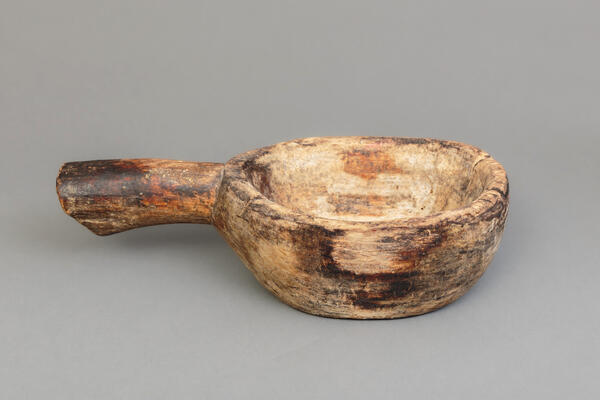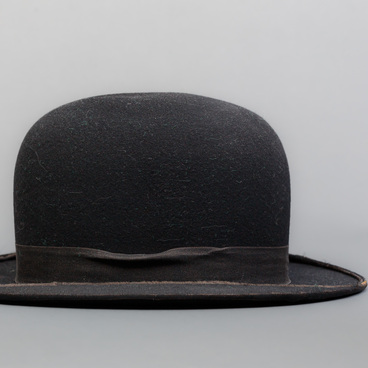A wooden kovsh— a vessel with a handle — was used in Russia from ancient times up to the mid-19th century. These vessels were produced en masse as early as the 10th century, the same as other wooden crockery. It was a trade streltsy and peasants were engaged in in the 16th–17th centuries.
These antique vessels varied in shape, size, complexity of decoration and purpose. Some were used to serve drinks, others for storing and pouring liquid or dry foodstuffs. The drinking kovsh (pityi) of a volume not exceeding two hundred grams were intended for water, brew, kvass or honey, and were considered a personal vessel. The ceremonial vessels were significantly larger and heavier. They were reserved for especially formal crowded feasts, and were decorated with embossed or engraved designs, coats of arms, and sometimes with the names of their owners.
The expensive palace kovsh was made of silver, with a heraldic eagle depicted on the bottom. Only members of the royal family had the right to use these dishes. There was a bestowed kovsh, a funeral kovsh, and also the one for wine, a kovsh shaped as a swan and so called a “konyukh” (horsekeeper’s) kovsh. The latter could hold up to two buckets (approximately 24 liters) of mead, beer or other spirits. The horsekeeper’s kovsh was accompanied by scoops, or “nalewki”, which were used to pour drinks into cups. The church utensils included a kovsh for holy water, ladles for zeon and communion drink.
Craftsmen from different regions adhered to their own traditions. Moscow craftsmen made the kovsh from burl, an overlay on tree trunks and roots. Such items were shaped like a flat-bottomed boat, and were usually set in silver.
In Tver, the kovsh was made solely from tree roots. These vessels were distinguished by their raised ends, which were carved in the form of horse heads. In the north of Russia, the kovsh was made with two handles (skobki), for which they got their name — skobkari (skopkari). Craftsmen made use of the original form, shaping one handle as a head, and the other as a tail of a horse, duck or even a dragon. Artisans decorated their products with carving or painting. All the vessels were made by chiseling — the outer side of the workpiece was worked on by scraping or cutting, while the inner part was chiseled out.
The mortar-kovsh on display was purchased from Alexei Kharitonovich Savinov, born in 1937, a resident of the Bolshesoldatsky district, village of Budische, Kursk region.
These antique vessels varied in shape, size, complexity of decoration and purpose. Some were used to serve drinks, others for storing and pouring liquid or dry foodstuffs. The drinking kovsh (pityi) of a volume not exceeding two hundred grams were intended for water, brew, kvass or honey, and were considered a personal vessel. The ceremonial vessels were significantly larger and heavier. They were reserved for especially formal crowded feasts, and were decorated with embossed or engraved designs, coats of arms, and sometimes with the names of their owners.
The expensive palace kovsh was made of silver, with a heraldic eagle depicted on the bottom. Only members of the royal family had the right to use these dishes. There was a bestowed kovsh, a funeral kovsh, and also the one for wine, a kovsh shaped as a swan and so called a “konyukh” (horsekeeper’s) kovsh. The latter could hold up to two buckets (approximately 24 liters) of mead, beer or other spirits. The horsekeeper’s kovsh was accompanied by scoops, or “nalewki”, which were used to pour drinks into cups. The church utensils included a kovsh for holy water, ladles for zeon and communion drink.
Craftsmen from different regions adhered to their own traditions. Moscow craftsmen made the kovsh from burl, an overlay on tree trunks and roots. Such items were shaped like a flat-bottomed boat, and were usually set in silver.
In Tver, the kovsh was made solely from tree roots. These vessels were distinguished by their raised ends, which were carved in the form of horse heads. In the north of Russia, the kovsh was made with two handles (skobki), for which they got their name — skobkari (skopkari). Craftsmen made use of the original form, shaping one handle as a head, and the other as a tail of a horse, duck or even a dragon. Artisans decorated their products with carving or painting. All the vessels were made by chiseling — the outer side of the workpiece was worked on by scraping or cutting, while the inner part was chiseled out.
The mortar-kovsh on display was purchased from Alexei Kharitonovich Savinov, born in 1937, a resident of the Bolshesoldatsky district, village of Budische, Kursk region.






